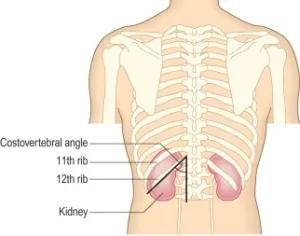10 key facts about kidneys

- Most people have two kidneys – they lie under the ribs and above the waist (at the back), one on either side of the body. 1 in 1000 people are born with one kidney and come to no harm
- Kidneys are bean shaped, and about the size of your palm; 12cm long, 6cm wide and 3cm deep. Each kidney weighs about 150g
- Even though the kidney only accounts for 0.5% of the body’s weight on average, it receives more blood (20% of the cardiac output) than all other organs except the liver
- Kidneys are the body’s dustmen. Why are they needed? The body takes nutrients from food and converts them to energy. After the body has taken the food components that it needs, waste products and extra water are left behind in the blood – and need to be removed
- They filter (and clean) your blood 35x a day, with a blood volume of 5 litres. Even though 180L are filtered, most of the filtered liquid is put back (reabsorbed) into the blood as only 2L of urine emerge each day. This is how waste products and extra water are removed from the body
- Kidneys have other functions. They also control the production of red blood cells, regulate the bones (including calcium and phosphate) and blood pressure
- Each kidney contains 1 million tiny filters called called glomeruli, which act as tiny sieves in the filtration process

- Chronic kidney disease (CKD) affects approximately 7 million (10%) of adults in the UK to some degree. There are 5 stages of CKD from CKD1 (most mild) to CKD5 (most severe). Fortunately most CKD cases are mild (Stages 1-3B) and age-related (most of these have no symptoms); with a smaller percentage progressing to moderate-severe CKD (CKD3B-4) or ESRF (end-stage renal failure, or CKD5). Only 1% of CKD patients eventually develop ESRF and require dialysis or a kidney transplant
- 2 commonest causes of CKD are: unknown (30%) and diabetes (20%). Black, Asian and minority ethnic communities are five times more likely to develop CKD than other groups
- In more advanced CKD – CKD4 and CKD5 (kidney failure) – harmful wastes build up in your body, your blood pressure will rise, and your body retains excess fluid, leading to ankle swelling and shortness of breath (water in the lungs). If CKD5 is reached, you will need dialysis or a kidney transplant – to replace the work of your failed kidneys.
Bonus Facts
- Most urinary tract infections (UTIs) are bladder infections (or cystitis). But if a UTI occurs in the kidney it is called pyelonephritis
- Kidney stones are very common. In fact, about 1 in 10 people will get a kidney stone during their lifetime They form when there is an accumulation of certain substances in the urine, causing them to crystallise and form solid masses. These masses can get stuck when leaving the kidney and cause a blockage in the ureter, which can be very painful (this is called renal colic). Many are composed of calcium oxalate
- Kidney cancer includes cancers of the outer kidney (90%; cortex and medulla), inner kidney (5%; pelvis, drainage system) and the ureter (5%)
Other resources
10 CKD facts
10 CKD5 (ESRF) facts
This is a good review article: Vaidya, 2022

